
| Main Page |
| Photo Galleries |
| Writing |
| Aikido |
| Zen |
| Peeps |
| Links |
| Contact |

 Himeji
Castle
Himeji
Castle
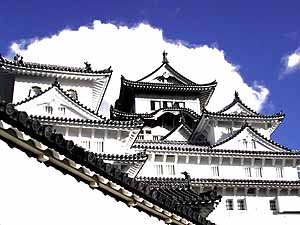 Himeji
Castle is one of Japan's most magnificent remaining castles, and stands
today as a great monument to Japan's medieval past.
Himeji
Castle is one of Japan's most magnificent remaining castles, and stands
today as a great monument to Japan's medieval past.
While most of the castles that can be seen in Japan today are ferro-concrete reconstructions that only outwardly resemble the buildings of the past, Himeji Castle is entirely constructed in the traditional style, with a superstructure crafted entirely of wood.
Fortifications have existed on this site since 1333, though the castle did not take on its current, and rather impressive form, until 1609 under the direction of Lord Tokugawa Ieyasu.
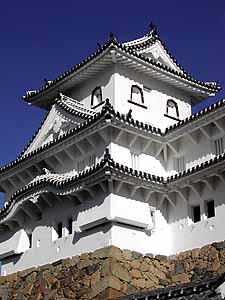 Situated
west of the Kansai cities of Osaka and Kobe, Himeji was a major power
centre and strategic transit point held by the Tokugawas. The castle is
a prime example of the extensive earthworks and defensive systems that
were used by the Japanese during that time, and can be considered to represent
the peak of Japanese castle architecture.
Situated
west of the Kansai cities of Osaka and Kobe, Himeji was a major power
centre and strategic transit point held by the Tokugawas. The castle is
a prime example of the extensive earthworks and defensive systems that
were used by the Japanese during that time, and can be considered to represent
the peak of Japanese castle architecture.
The castle walls themselves, which are mounted high upon the stone walls and earthworks, are filled with gun and arrow slits, as well as openings intended to allow the defenders to pour hot oil and tar on any attackers.
The interior of the castle is divided into various sections which can be isolated in the case of a breach, and the donjon - or central keep - was again divided into a number of defensible levels which would allow the defenders to drop back to various positions in the seemingly unlikely case that attackers were able to gain entrance in force.
 The
result is a multi-layered building of impressive dimensions, made all
the more dazzling by the fact that it is covered in a dazzling layer of
white plaster.
The
result is a multi-layered building of impressive dimensions, made all
the more dazzling by the fact that it is covered in a dazzling layer of
white plaster.
The impressive stone ramparts were built without any mortar holding them together, but are instead laid out in such a way that they are held together by gravity, as they are in Nijo Castle.
Most of the stones were gathered together by common people throughout the realm in a show of support for the Lord. The most famous case of this was when a poor old woman donated her only millstone to the cause...apparently this was rather inspiring at the time, rather than simply depressing that some warlord was robbing his people of their livelihoods so that he could build a better castle...but I digress. Plus ca change...
The pictures can hopefully give a sense of the size of the place, as the towering structure can be seen from miles away. Travelling inside and climbing to the upper levels affords a panoramic view of the surrounding city that is absolutely breathtaking.
 |
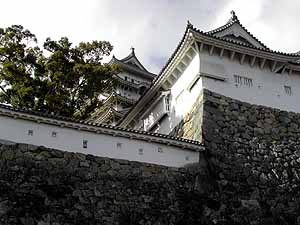 |
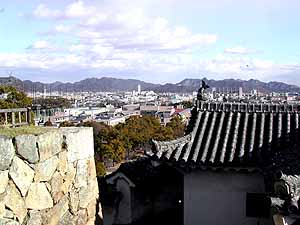 |
 |
Also of particular interest to me is the fact that the famed
swordsman, Miyamoto Musashi, spent three 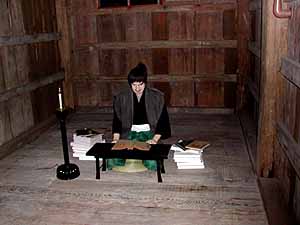 years
confined in a tiny room high in the central keep of the castle.
years
confined in a tiny room high in the central keep of the castle.
Though now there is nothing in the room but a slightly cheesy statue of a very strange looking 'Musashi', seeing the room really drove home the kind of hardship he had lived through in his life. He was put there at the request of Takuan Soho (or so the legend goes) in lieu of being executed for an alleged crime, and he spent the next three years with nothing but the literary collection of then Lord Ikeda to keep him company. It was at this point in his life that Musashi was to have acquired his knowledge of the Art of War.
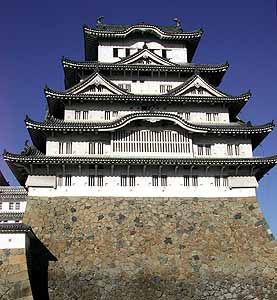 The central donjon of the castle, which though tall itself is situated on the top of the ridge upon which the castle is built, giving it a commanding view of the surrounding valley. |
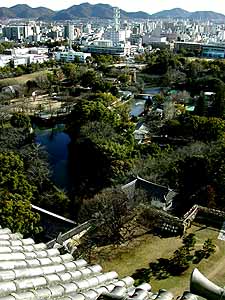 And here is the aforementioned commanding view...so high up that you have to remind yourself that the wood and plaster building is over 400 years old. |